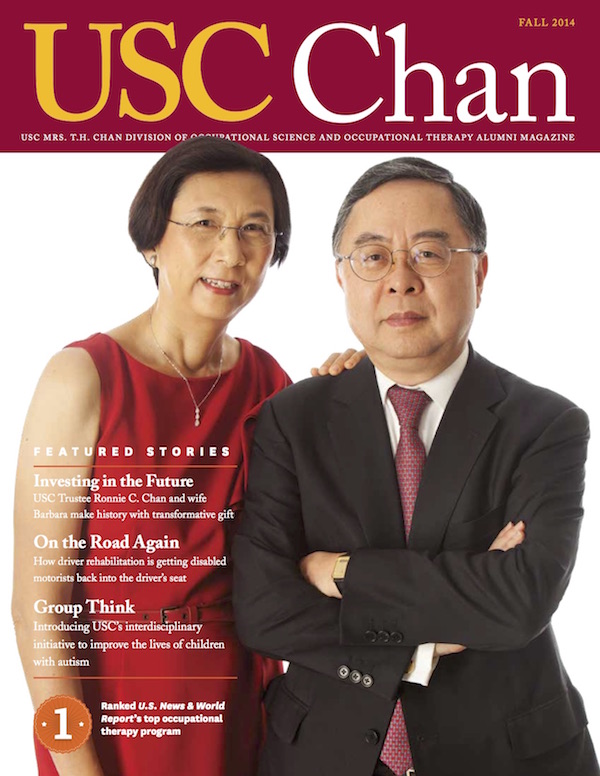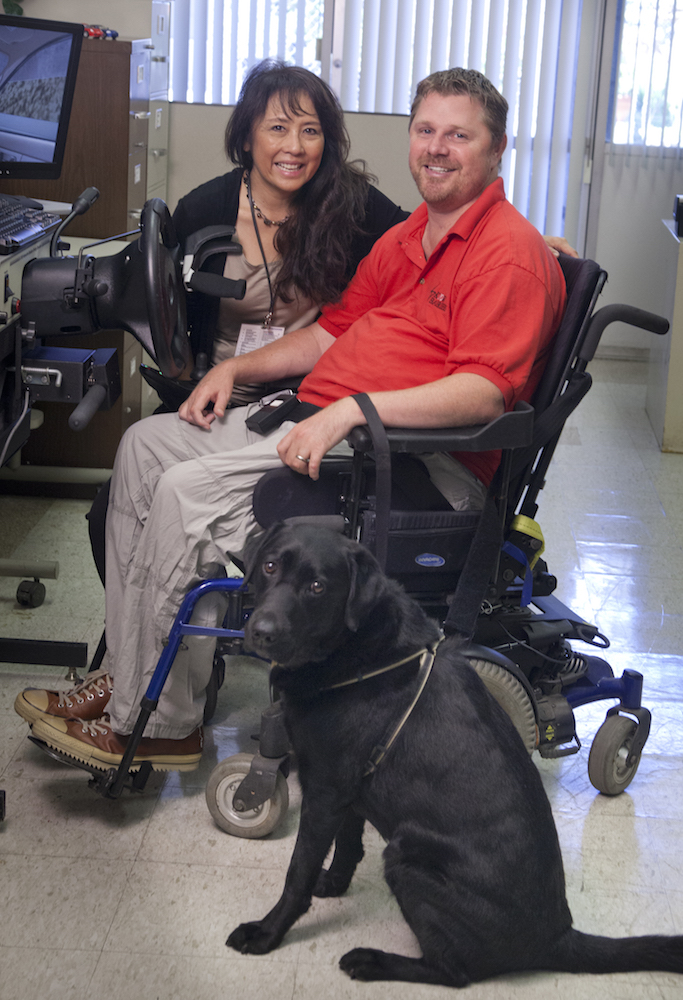On the Road Again
A hiking accident might have left actor-comedian Jay Cramer partially paralyzed, but he’s not stuck in neutral, thanks to the OT Driver Rehabilitation Program at Rancho Los Amigos National Rehabilitation Center.
By Yasmine Pezeshkpour MCM ’17
Lying there facedown in the cool canyon water, Jay Cramer didn’t quite feel right.
It’s not like falling from the boulder’s face into the hip-deep water below was a new experience. He had taken spills twice before as he and his buddies slowly traversed the rocky landscape in Malibu Canyon that Tuesday morning.
But something felt different about this fall. When Cramer, then 30 years old, tried to roll over on his back, he discovered he couldn’t. His arms and legs no longer felt like they were his own.
“Your whole life changes in the blink of an eye,” Cramer says.
It was supposed to be a day of celebration. Cramer, an actor-comedian who had moved to Los Angeles seven years earlier to pursue stardom, had found out he was a semi finalist to be a contestant on Survivor. In anticipation of the adventure ahead, he and his friends had set out to get him prepared for a spot on the CBS reality show with a bouldering excursion. Bouldering is a style of rock climbing where climbers do not wear safety harnesses because they are typically no more than 20 feet off the ground.
It hadn’t been the distance he fell that had caused Cramer’s immobility, though. “As I pushed off the boulder, I tried to do a backwards double jack knife off the rock,” Cramer says. That push-off caused him to hit his head on a rock in the middle of the water.
The impact immediately shattered his fifth cervical vertebrae, the corresponding nerves of which control arm and hand movement.
Cramer was airlifted from the canyon and underwent a grueling, nine-and-a-half-hour surgery to repair the damage to his body from the fall. When he awoke, he was surprised to see 14 of his friends had stayed the night at the hospital, anxiously awaiting any updates on his condition. Unable to speak, Cramer indicated to his visitors he was OK.
“I showed them through my eyes that I was exactly the same guy as always,” Cramer says. “But now things are just going to be a little bit different.”
Following surgery, Cramer was in intensive care for 41 days before being released to re-learn the skills necessary to get back to the life he had once known. “It wasn’t easy for me,” says the independent-minded Cramer. “I had to have help all the time, and I just wanted to get up and do things on my own.”
Now 39, Cramer gets around with the help of a power wheelchair and a retired service dog named Goliath.
Just a few months after surgery, Cramer was cleared to begin rehabilitation at Rancho Los Amigos National Rehabilitation Center. “Once you’re ready for therapy, they really throw you in the mix,” he says. “That means neck brace off, sitting upright in your wheelchair for eight hours and re-learning day-to-day tasks.”
During his time at Rancho, the affable Cramer made fast friends by falling back on his characteristic humor during tough times.
“I would meet people and tell them my story — of course adding a little humorous spin on it — and they would tell me how funny I was and that I should try out stand-up comedy,” Cramer says. “I had been an actor for years. I had done my share of sketch comedy and improv, but I never had the guts to try stand-up until I broke my neck.”
Exactly four months to the day after his accident, Jay landed his first stand-up comedy gig, and it was a hit. The experience and positive audience feedback inspired him to sign up to do even more stage appearances, which required him to travel from Burbank, Calif., to Hollywood, Calif., two to three times a week. It’s one thing for an actor to sit in traffic every day traveling to appearances, but quite another when you have to depend on others to get you there on time.
“I couldn’t just get up and go when I wanted since I couldn’t drive,” says Cramer, who would take the Access Paratransit — a ride-share program for people with disabilities — to Hollywood. “It’s great for getting around,” he says, “but very limiting for someone like me who was coming and going to auditions, work and other activities throughout my day.”
While Cramer was very grateful for the Access van, his dependence on it often made him miss stage time or kept him waiting for rides long after the shows. One day while waiting for a ride, his buddy suggested Cramer should get his own car. Cramer knew that if he wanted to continue to pursue his passion he would need to get his own car to regain the freedom of coming and going at his own will.
With the help of several grants, Cramer was able to save enough for the down payment on a navy blue Dodge Caravan.
For someone with a disability to drive safely, a vehicle often has to be outfitted with wheelchair lifts, hand accelerators and brakes or pedal extensions — all dependent upon the driver’s condition. It means learning a whole new skill set. For example, someone with a right foot amputation due to diabetic neuropathy must learn to brake and accelerate with their left foot. For someone who has lost use of both legs — like Cramer — it can mean learning to accelerate and brake with your hands.
California’s Department of Motor Vehicles advises people with disabilities to undergo proper training before getting behind the wheel. DMV specialists conduct interviews and screening evaluations before giving clearance for an on-road and written exam. The process has to be repeated every five years.
To prepare for his driving test, Cramer decided to connect with Sandra Okada ‘79, MSG ’88, CDRS, a certified driver rehabilitation specialist. Okada has been working at Rancho for the past 25 years, 18 of which she has spent with the OT Driver Rehabilitation Program. She understands the need for the driver rehabilitation program to get people back on the road.
“It’s especially difficult in a city like Los Angeles not to have a car,” Okada says. “We hope that in a way the program gives our clients a sense of freedom and independence back.”
The driver evaluation and training program has been assisting patients in becoming safe drivers since 1957. The program offers a pre-driving screening and education, behind-the-wheel courses and assistance with DMV preparation, as well as with vehicle modification evaluations.
Would-be drivers can gain valuable experience behind the wheel of the program’s driving simulator, which allows users a video-game type of immersive experience using some of the typical car modifications made for a handicapped driver. With three simulated screens facing them in wrap-around fashion, drivers are challenged by adverse weather conditions like rain and fog and can choose various surfaces like mountain roads and freeways to improve their skills. The experience increases their confidence behind the wheel without presenting any of the associated risks of an actual on-road encounter.
Once they get comfortable with the simulator experience, they hit the roads around Rancho with occupational therapists in the car behind them, noting further adjustments necessary for a safe driving experience.
Every year, Rancho partners with the USC Chan Division of Occupational Science and Occupational Therapy, where Okada also teaches the course to candidates of the master’s in occupational therapy degree. The course, titled Adult Physical Rehabilitation Practice Immersion, allows the students to learn about the driving rehabilitation program and the assistive technologies at the Center for Applied Rehabilitation Technology.
“Learning about spinal cord injury and driving an adapted van is not really something students can appreciate until they hear Jay’s story and see him get into and out of his van with his controls, his adaptations,” Okada says. “It really makes the learning experience come to life.”
With Okada’s help, Cramer was able to receive his driver’s license in 2008, nearly three years after his accident. “It was a freeing experience,” he says. “Someone in the program once told me a van is as important, if not more, as the wheelchair, and I couldn’t agree more.”
Cramer was such a valuable asset to the Rancho culture that he now serves as a peer mentor supervisor and life coach for the Rancho Know Barriers and Peer Mentor Program. “I tell patients here that it’s OK to feel sad,” he says. “But the key is getting past it because there is much more life to live. It’s important for me to help people get through that as others did for me.”
It is also in this role that he assists Okada in driver demonstrations for students and clients.
Cramer still manages to pursue his talents in acting. He recently made an appearance on the prime time television show, Grey’s Anatomy. “I always thought about being a doctor, but my grades in acting class were always higher than in science,” he jokes. “In a way the role on Grey’s Anatomy allowed me to experience the best of both worlds.”
Nine years after the accident, Cramer says he wouldn’t change a thing. “It has been the best thing that ever happened to me,” he says. “You gain a tremendous amount of perspective on who you are, what you’re capable of and you learn what you really want out of life.”
Fast Track
How the driver rehabilitation program gets disabled drivers back into the driver’s seat:
- Group Training. The program prepares prospective drivers with group trainings explaining the process in California for getting a driver’s license.
- Simulated Driving. Certified driver rehabilitation specialists work with individuals using a driving simulator to get motorists comfortable behind the wheel.
- Hitting the Road. The driver rehabilitation specialists assess the driver’s skills on roads around Rancho in a vehicle outfitted for a disabled driver.
- Taking the DMV Test. The DMV assessment includes in-person interviews as well as written and road tests and must be repeated every five years for license renewal.
It can take up to six one-hour sessions to teach someone with lower-extremity paralysis from a spinal cord injury to learn to use hand controls to brake and accelarate, according to Okada.
⋯








